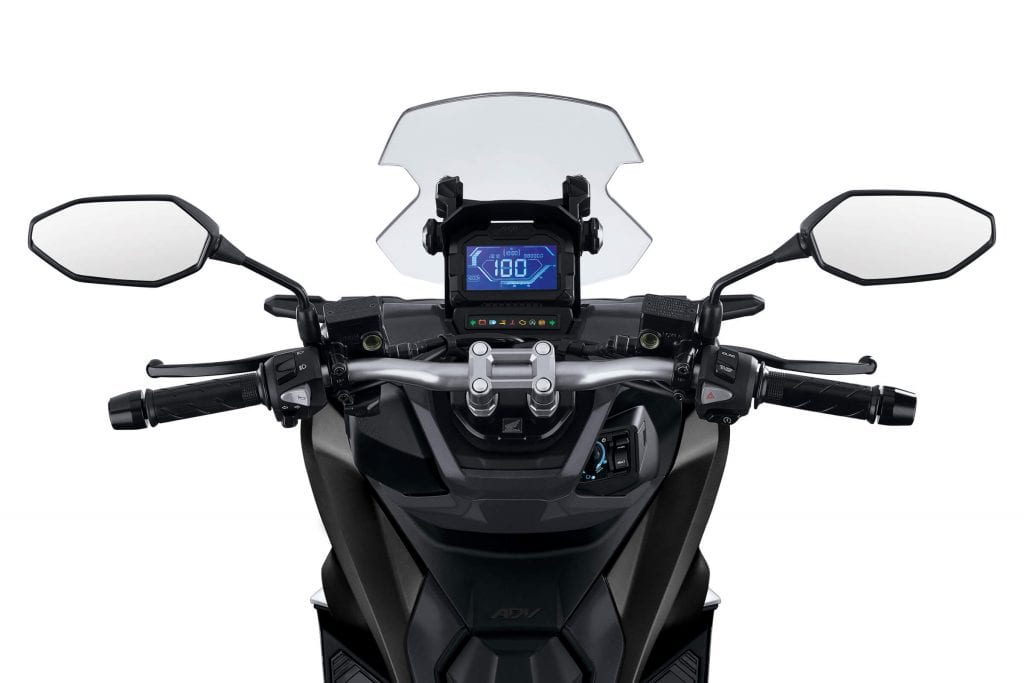HONDA AD 1V50
Honda’s first “Adventure” scooter – the ADV150 – arrived in the USA during summer 2020 as an early release 2021 model. This new model is based on Honda’s refined PCX150 platform, but puts a unique adventure twist on scootering with aggressive styling and high travel suspension.
Motor
The ADV150 borrows it’s 149cc motor from Honda’s PCX150, which is a good thing because the PCX motor is about as good as it gets. It’s the latest generation mid-sized engine from Honda and boasts exception efficiency and reliability.
This motor is liquid cooled and fuel injected, but only 2-valves and with a modest 10.6:1 compression ratio that likely contributes to a longer life. Despite a compression ratio that isn’t that high, Honda is recommending premium fuel for the ADV150, which offsets some of the fuel savings from a machine rated over 100 mpg and actually delivering closer to 80-90 mpg in real world use.
Power is spec’d at 14.5 horsepower at 8500 RPM, which interestingly is over 1 horsepower higher than the PCX (rated at 13.3 horsepower) despite sharing the same core engine and throttle body. Honda must have souped it up somehow, but the ADV150 also has greater wind resistance with its taller stance and is a slightly heavier machine (294 lbs vs 289 lbs) so we don’t expect much difference in top speed. Honda is saying 73 mph top speed for the ADV150, which is the same as the PCX.
Overall, it should be a snappy scooter up to about 60 mph and then it’ll wander higher from there. If that’s not fast enough for you, there are aftermarket kits out now for 164cc and beyond but you’d be jeopardizing the exceptional reliability and efficiency this motor is known for.
Style
The ADV150 certainly is a unique looking scooter. With roughy 5 inches of suspension front and back (versus the typical 3”) the ADV sits noticeably higher than the average scooter and further looks a bit top heavy with the bulky front end (although Honda assures us that it doesn’t handle like that due to a lower center of gravity including a floorboard located fuel tank).
Parts of the ADV look executed very well, including the gorgeous rims and muscular styling on the rear half. More debatable is the front end style, where the robotic look works, but may age faster than the traditional styling Honda normally uses on their adventure bikes. It reminds us of Yamaha’s old TMAX scooter, which hasn’t been sold in nearly a decade now but still looks pretty good.
Brakes and Suspension
Honda equipped the ADV150 with a serious suspension. Not only does it have dual rear shocks, but they’re from esteemed suspension company Showa, and they further boast huge travel for a scooter at 5.1”. Up front is a 31mm fork that is also from Showa and again boasts huge travel with 4.7”. For comparison, the PCX150 has merely half that at 2.4” (front) and 3.3” (rear). Undoubtably, the ADV150 has the best suspension anyone has ever put in a mid-sized scooter, and is the one part of this scooter that is adventure worthy. Although even here we note that proper adventure bikes like Honda’s Africa Twin tend to have more like 9” of travel.
Where things get a bit more disappointing is the brakes. Honda has carried over the medicore rear 130mm drum brake from the PCX, which means you’re going to be relying on that if you venture off road and find yourself on slick terrain. Upfront Honda has increased the size of the rotor from 220mm up to 240mm, which should be okay but is still a single piston operation. Like many attributes of this scooter, it’s a step up over the standard fare but nowhere near legitimate adventure spec.
Also a bit of a let down if you were hoping for real adventure use are the small wheels at 14” (front) or 13” (rear). Had Honda opted for at least 15” then riders would have better handling on choppy surfaces and more choices in tires. Overall, Honda made some efforts here to improve this scooters capability, but also stopped well short of a true adventure machine. Likely because they didn’t want to have to re-design the entire PCX transmission. Thus it ends up being a scooter for rough urban roads and railroad tracks moreso than actual backroads use. Honda doesn’t really dispute that, calling it a machine for the “gnarly commute” and the “asphalt jungle”.
 Amenities
Amenities
The ADV150 comes equipped with a nice 2 position windscreen that Honda claims actually works at high speeds to reduce wind buffeting.
There’s also a healthy underseat storage compartment of 27L, and a handy 2L storage area in the legshield with a 12V port. Plus an optional rear top case for further storage.
The dash uses a slick LCD screen that looks great, and further ups the technology with their SMART key fob that allows keyless push button starts. We also appreciate the fuel and seat popping button on the legshield carried over from the PCX, so you don’t need to pull out your key to open those.
On the downside, the fuel tank is small at 2.1 gallon (8 liters) – likely because they couldn’t fit in a bigger tank than what the PCX has. The ADV150 does get excellent fuel economy so you might get nearly 200 miles / 300km on that, but still nowhere near the range of a proper adventure bike.
Discussion
Everyone loves the idea of a little adventure bike, which is why the ADV150 sounds like a cool bike until you realize that Honda has designed it for “city adventures” and taking on the “asphalt jungle”. There’s minimal backroads intention here. Well Honda did give it a robust suspension but with narrow tires, modest brakes, a small fuel tank and scant other adventure bike attributes (e.g. larger alternator, extra storage, larger rims) there’s not too much to get excited about. If you’re buying this it’s likely because you like the style or ride on rough asphalt, moreso than because you’re planning a ride to Patagonia. And that’s okay. Honda needs these to sell and the urban warrior is a much larger market.
Once you get past that disappointment, it’s a pretty neat scooter. The brakes, tires, suspension, motor etc might not be adventure grade but they are a step up over most scooters including legitimate premium features like dual Showa shocks and ABS, for only a few hundred more than Honda’s PCX (when you compare the ABS version) which shares the same powertrain as the ADV150. Honda avoided the temptation to price this like an exotic special editions, so being a fair value quite likely many people will deciding between this and Honda’s PCX mostly on style. We’d take the ADV.
Looking at other brands, the obvious competitor is Yamaha’s S-Max 150 ($3799), which is a more dated model and half a step behind technologically, but also $500 cheaper. We think the Honda is the better buy, as the extra $500 nets you ABS, better suspension, and a machine that is ahead technologically (e.g. more advanced motor).
Please consider adding an owner review of your Honda ADV150. It benefits other readers and improves this site.
Pros:
- Premium suspension
- Adjustable windscreen
- Standard ABS
- Refined powertrain
Cons:
- Limited actual off-road capability
- Mediocre styling
Links:
- MotorscooterGuide Forums – Visit the forum on this site to chat about your scoot.
Key Specs:
- Engine: 149cc, 2-valve, 4-stroke, SOHC, liquid cooled single
- Power: 14.5 HP at 8500 RPM, 10.3 ft-lbs torque at 5000 RPM
- Compression: 10.6:1
- Bore x stroke: 57.3 x 57.9 mm
- Fuel system: PGM-Fi electronic fuel injection
- Wet weight: 133 kg (294 lbs)
- Seat height: 31.3”
- Wheelbase: 52.1”
- Front suspension: 31mm Showa hydraulic fork with 5.1” travel
- Rear suspension: Twin Showa shocks with 4.7” travel
- Tires: 110/80-14 (front), 130/70-13 (rear)
- Front brakes: Single 240mm disc, ABS standard
- Rear brakes: 130mm drum
- Fuel capacity: 2.1 gallon / 8 liters
- Years sold: 2021 – present
- USA MSRP: 2021 $4299
Colors:
- 2021: Black

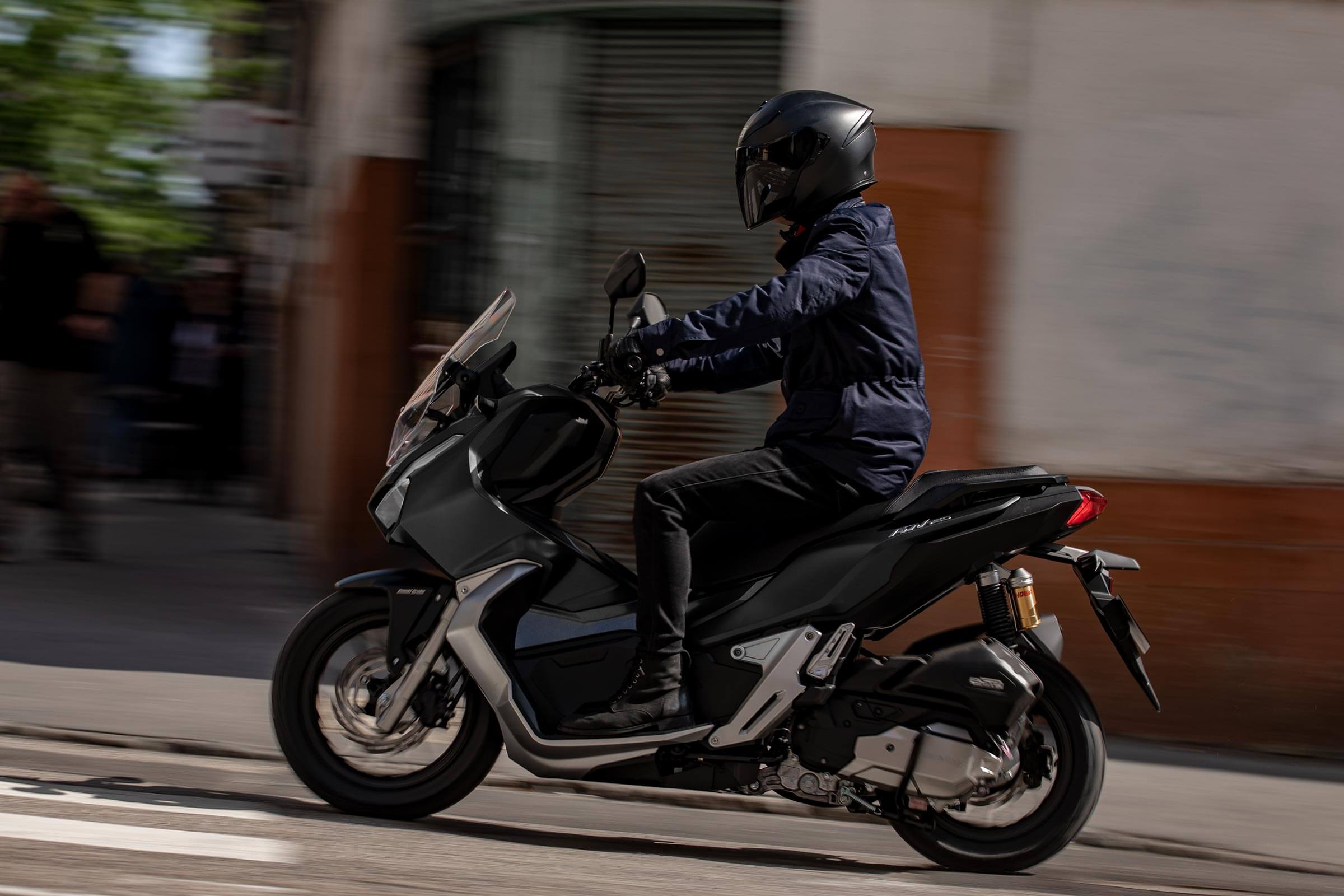
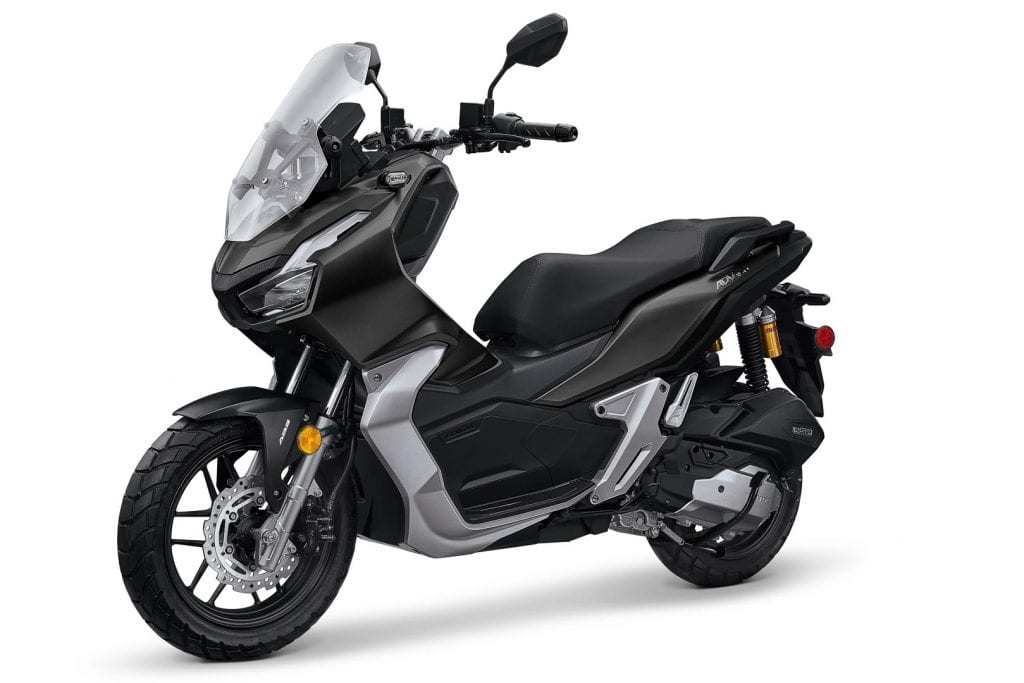
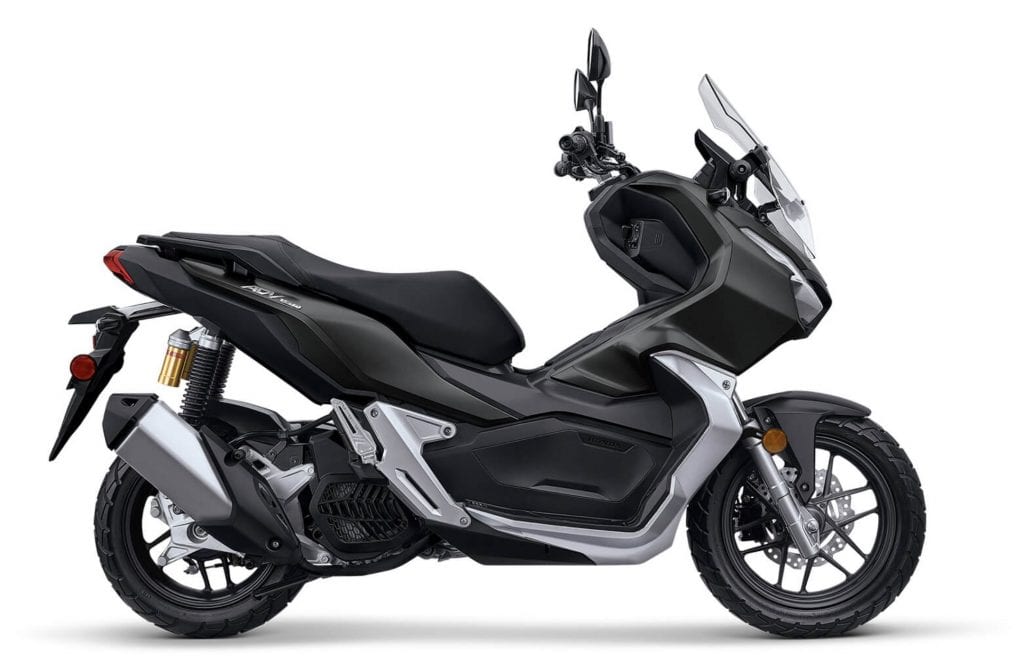
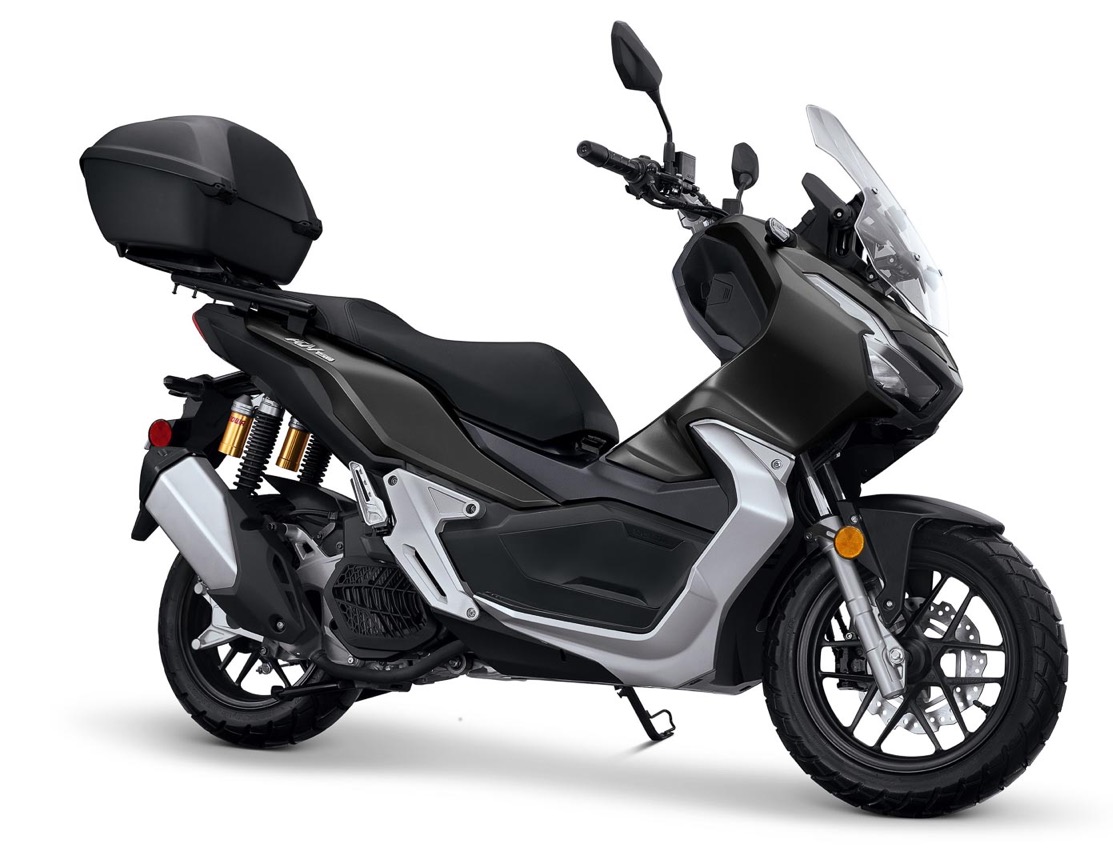
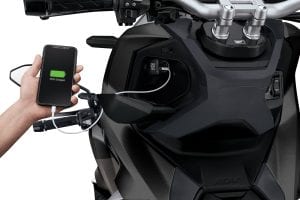 Amenities
Amenities